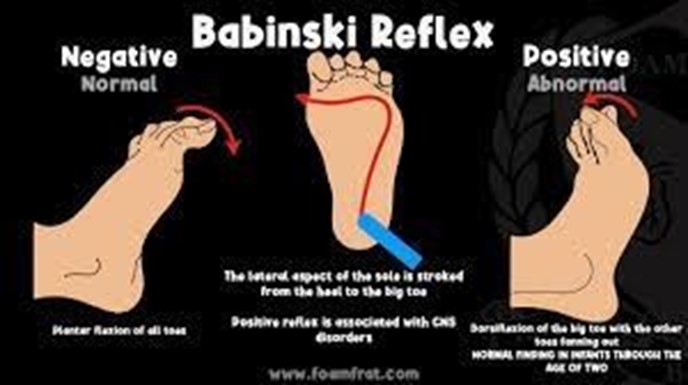A nurse is assisting a client with breastfeeding her newborn. The nurse should explain that which of the following reflexes will initiate sucking?
Moro.
Rooting.
Stepping.
Babinski.
The Correct Answer is B
Rooting. Choice A rationale:
The Moro reflex is a startle reflex characterized by the infant's sudden extension and abduction of the arms in response to a loud noise or sudden movement. It is not involved in the initiation of sucking and is unrelated to breastfeeding.
Choice B rationale:
The rooting reflex is a crucial reflex that helps initiate sucking in newborns. When the infant's cheek is stroked or touched, they will turn their head toward the stimulus and open their mouth, preparing for feeding. This reflex helps the infant find the mother's nipple and begin breastfeeding effectively.
Choice C rationale:
The stepping reflex is a primitive reflex observed in newborns when held upright with their feet touching a solid surface. The baby will make stepping movements, mimicking walking. However, this reflex is not related to the initiation of sucking and breastfeeding.
Choice D rationale:
The Babinski reflex is a reflex in which the big toe extends upward and the other toes fan out when the sole of the foot is stimulated. This reflex is present in newborns and disappears as the child grows older. It is not involved in the initiation of sucking.
Nursing Test Bank
Naxlex Comprehensive Predictor Exams
Related Questions
Correct Answer is D
Explanation
Choice A rationale:
"He is just cold”. is not the correct choice. While newborns can have cold hands and feet due to their immature thermoregulation, it would not explain persistent blue hands.
Choice B rationale:
"He may have been born with a heart problem”. is not the correct choice as it suggests a congenital heart defect. While cyanosis (bluish discoloration) can be associated with some heart problems, the hands alone being blue is less likely to be solely related to a heart issue.
Choice C rationale:
"The hands are always blue in a newborn”. is not the correct choice. While newborns may have bluish extremities (acrocyanosis) during the first few days after birth due to their developing circulatory system, persistent blue hands beyond this period would require further assessment.
Choice D rationale:
The correct choice is that "The circulation in his hands is not fully developed.”. Newborns have a developing circulatory system, and sometimes, their peripheral circulation takes some time to mature, leading to transient blue hands. However, if the blue color persists or worsens, it's essential to evaluate for any underlying issues.
Correct Answer is ["A","C","D","F"]
Explanation
Choice A rationale:
The newborn reflex called "rooting”. is characterized by turning the head and opening the mouth when the cheek or mouth area is touched. This reflex helps the newborn find the mother's breast for feeding.
Choice B rationale:
"Stepping”. is a newborn reflex where they make stepping movements when held upright with their feet touching a solid surface. This reflex is present at birth but tends to disappear after a few weeks.
Choice C rationale:
The "Moro”. reflex is also known as the startle reflex. It is elicited by a sudden loss of support or loud noise, causing the newborn to throw their arms and legs out and then bring them back in. This reflex usually disappears around 3 to 4 months of age.
Choice D rationale:

The "Babinski”. reflex is characterized by the extension of the big toe and fanning of the other toes when the sole of the foot is stroked. This reflex is present in newborns and should disappear by around 12 months of age.
Choice E rationale:
"Running”. is not a recognized newborn reflex. There is no reflex with this name related to newborns.
Choice F rationale:
The "gag”. reflex is present in newborns and helps protect the airway by causing a gagging response when the back of the throat is stimulated.
Whether you are a student looking to ace your exams or a practicing nurse seeking to enhance your expertise , our nursing education contents will empower you with the confidence and competence to make a difference in the lives of patients and become a respected leader in the healthcare field.
Visit Naxlex, invest in your future and unlock endless possibilities with our unparalleled nursing education contents today
Report Wrong Answer on the Current Question
Do you disagree with the answer? If yes, what is your expected answer? Explain.
Kindly be descriptive with the issue you are facing.
